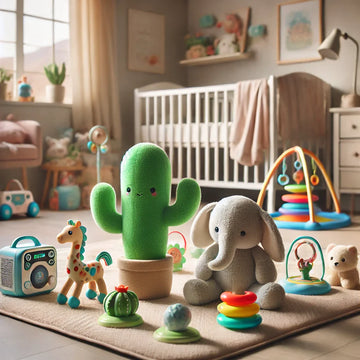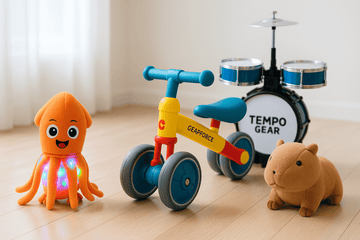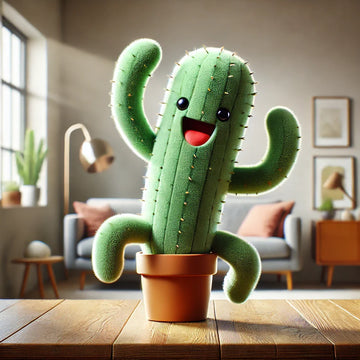Introduction
The Ongoing Debate – Plush Toys vs Plastic Toys
From baby showers to birthdays, choosing the right toy sparks a common question for many parents: Should I choose plush or plastic? In 2025, the toy aisle is brimming with options—many of which light up, sing, move, and mimic your child’s voice. But beyond the fun and features, safety remains the top concern, especially when shopping for babies, toddlers, and sensitive kids.
Why Parents Are Rethinking Toy Safety in 2025
With increasing awareness of non-toxic materials, choking hazards, and emotional development, parents are taking a closer look at what their kids are playing with. That’s why plush interactive toys have soared in popularity—they’re soft, safe, and support early development in ways plastic toys often can’t.
Understanding the Key Differences
Materials – Fabric vs. Plastic
-
Plush Toys: Made with soft, breathable fabrics like cotton or fleece, plush toys offer gentle texture, cuddly form, and a soothing touch.
-
Plastic Toys: Usually rigid, bright, and often battery-powered, they can be less forgiving when thrown or chewed.
Durability, Flexibility, and Sensory Feedback
-
Plush toys are flexible and forgiving, ideal for children still learning spatial awareness.
-
Plastic toys may last longer outdoors but can cause injury if misused indoors or during tantrums.
Why Plush Toys Are Safer for Babies and Toddlers
Gentle on Skin, Eyes, and Mouth
Babies explore with their mouths. That’s why soft toys for infants are a safer bet. There are no sharp corners or hard surfaces that can bump or bruise.
Reduced Choking Hazards and Sharp Edges
Plastic toys often include small detachable parts, while plush toys are typically designed as a single unit with embroidered or stitched features that stay put.
Soft Toys for Infants – Designed for Cuddles and Play
Soft plush toys are easy to grip, calming to hold, and safe to nap with—qualities that plastic toys simply don’t offer.
Non-Toxic Toys for Toddlers – What to Look For
Certified Safe Materials
Look for plush toys labeled:
-
EN71 or ASTM F963 compliant
-
Hypoallergenic
-
Free from flame retardants, BPA, and heavy metals
BPA-Free, Dye-Free, and Hypoallergenic Labels
Many modern plush toys are made with eco-friendly dyes and organic cotton, which is especially important for kids with eczema or skin sensitivities.
Plush Toys That Meet International Safety Standards
Top picks like LeapFrog Scout, Dancing Cactus, and VTech Baby plushies are made to meet international child safety guidelines, including secure battery compartments and chew-safe surfaces.
The Emotional Comfort of Plush Interactive Toys
Why Softness Matters for Sensitive Kids
Some children are sensory seekers, others are avoiders. For sensitive kids, plush toys provide:
-
Gentle stimulation
-
Emotional grounding
-
A sense of security through softness
Plush Toys as Transitional Comfort Objects
Toys like Scout or the Peek-A-Boo Elephant become companions that ease transitions, help with routines, and reduce anxiety during sleep or travel.
Enhancing Development Through Gentle Interaction
Interactive plush toys teach:
-
Cause and effect through gentle sound
-
Turn-taking with mimic features
-
Language development via songs and phrases
When Plastic Toys Might Still Have a Role
Durable Learning Toys (When Supervised)
Plastic toys with buttons and educational screens have their place—particularly in structured settings or for short sessions with adult supervision.
Water Play and Outdoor Use Cases
Plastic toys are ideal for bathtime and beach play, where plush toys would absorb moisture and get damaged.
Balancing Variety Without Compromising Safety
The key is knowing when and where to use each type of toy. For everyday comfort and safe play, plush still wins.
Expert Opinions – Pediatricians and Toy Safety Specialists
What Doctors Recommend for Infants and Toddlers
Pediatricians recommend:
-
Avoiding hard plastic toys for children under 18 months
-
Choosing plush toys with no removable parts
-
Prioritizing soothing textures and safe sound levels
Insights from Child Psychologists on Comfort Play
Psychologists highlight plush toys as tools for self-soothing, emotional expression, and bonding—critical during the toddler years.
Top Safe Plush Interactive Toys in 2025
Dancing Cactus Toy – Mimic and Movement
-
Mimics voice
-
Plays songs
-
Encourages speech and laughter
-
Safe for toddlers when bought from trusted sellers like Mr. Cactus Australia
LeapFrog Scout/Violet – Educational and Soft
-
Personalized songs
-
Teaches routines and vocabulary
-
Super soft and fully interactive
VTech Baby Lullaby Bear – Soothing Sounds
-
Soft lullabies
-
Gentle lights
-
Perfect for bedtime routines
Peek-A-Boo Elephant – Soft and Engaging
-
Floppy ears cover eyes
-
Interactive peek-a-boo game
-
Ideal for babies building object permanence
FAQs – Choosing Safe, Non-Toxic Toys
Q1: Are all plush toys safe for babies?
Only those designed for under 12 months—look for age labels and certifications.
Q2: Can interactive plush toys be washed?
Some have removable electronics, others are spot clean only—always check labels.
Q3: Are plastic toys bad for toddlers?
Not always—but they should be supervised, age-appropriate, and made with safe materials.
Conclusion: Choose Plush for Safer, Softer Play
When it comes to choosing between plush toys vs plastic toys, the evidence is clear: plush wins for safety, sensory comfort, and emotional support. While plastic has its role, especially in learning and outdoor play, soft interactive toys offer a safer, more nurturing environment for babies and toddlers.
From the beloved Dancing Cactus to LeapFrog’s educational buddies, plush toys are the perfect choice for today’s thoughtful, safety-conscious parents.




